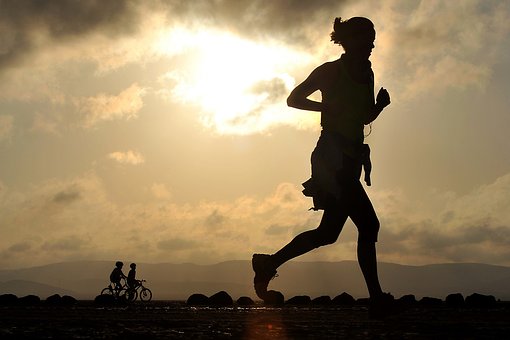By WIN Contributor: Jeff Dill, Physiotherapist
With the warm weather upon us a lot of runners will gladly be hopping off the treadmill and taking our running to the roads. There’s a sense of freedom that road running provides which the treadmill simply cannot match. With this sense of freedom comes the urge to run a little bit further, a little bit faster, a little more often. Our enthusiasm can sometimes lead us towards developing one of the more common injuries sustained in runners: iliotibial band friction syndrome (ITBFS). (1)
What is the Iliotibial Band?
The iliotibial band (IT band) runs from the top of our hip, down the side of our thighs, to just below the knee. It is a thickened piece of fascia (think saran wrap) which assists in providing stability to the outside part of our knee. The large gluteus maximus (buttock) muscle as well as a smaller muscle on the outside of our hip (tensor fascia latae- TFL) also have insertions into the IT band.
What Causes ITBFS?
There are a few main causes of IT band friction syndrome. (2) When we run our knees bend and straighten hundreds to thousands of times. This creates a rubbing over the side of our knee (the bony part as well as the fat pad underneath). Overtime, especially if we run too far, too soon (ie. overtraining), this constant rubbing can irritate the side of the knee and create pain and inflammation.
Another contributing factor can be weakness of our hip abductor muscles, in particular the gluteus medius. Although this muscle is much smaller relative to the large gluteus maximus (buttock) muscle, if the gluteus medius muscle becomes weak our thighs are more prone to turning in and “crossing over” when we run. This will put a lot more tension on the IT band, and will lead to increased rubbing at the knee. (3) Overtime this can also irritate the side of the knee, as well as the fat pad underneath it, causing pain and potentially leading to ITBFS.
How to You Know When You Might Have ITBS?
The primary symptom patients with ITBS report is a sharp pain located around the outside of the knee. However, pain may also be felt along the outer thigh or even into the calf muscle. (4) The pain may not be felt at rest but will become worse when running, especially running long distances or downhill. (2) Pain may also be felt if you apply pressure to the outside of your knee while simultaneously flexing/extending your knee.
What Can Be Done to Treat ITBS?
Although ITBFS can be a frustrating injury (necessitating a reduction or cessation of running), with proper treatment ITBS can be effectively managed. Treatment goes through three main stages: acute, sub-acute, and Strengthening/Recovery phase5.
Acute/Sub-Acute Stages: reduce pain and inflammation; stretching
– interventions include icing outer aspect of knee, reducing running volume/incorporating other cross-training activities, and stretching
– One good stretch involves standing with the affected leg behind, unaffected leg in front and across your body (for support). Then reach the arm on the affected side up and over towards the opposite side of the body, pushing your affected hip out to the side to increase the stretch. Hold this for around 30-60 seconds and repeat 2-3x, multiple times throughout the day.
o For example, if your right side is affected, you’d stand with your left leg crossed over in front of your right leg, then reach your right arm up and over your head towards the left, all while pushing your right hip out to the right.
Strengthening/Recovery Stage: strengthen hip muscles, in particular the gluteus medius
– Exercises will progress as strength is built; progressing too soon may exacerbate symptoms
– All exercises should be pain-free
– An example of an early stage exercise is the side lying hip abduction. For this exercise lay on your unaffected side, with your top leg straight. Then lift the top leg straight up 8-12”, holding for a second or two at the top. Slowly lower and repeat 8-15 times for 2-3 sets.
– Other techniques which may assist in healing include the use of ultrasound, laser and soft-tissue release techniques.
By systematically progressing through these stages of recovery, along with a touch of patience and guidance from a physiotherapist, you can overcome ITBFS and get back on the roads, pain-free, and stronger than before! If you have questions or are seeking guidance to help you in your running or to prevent or address injuries from running, or other sports, visit with me at WIN Health Solutions and I’d be happy to help.
References:
1. Van Der Worp Maarten et al., Iliotibial Band Syndrome in Runners, Sport Medicine (2012).
2. Wong M. Pocket Orthopaedics, Evidence-Based. (2009) Jones and Bartlett Publishers.
3. Robert L. Baker et al., Iliotibial Band Syndrome in Runners : Biomechanical Implications and Exercise Interventions, Physical médicine and réhabilitation clinics of North America, (2016).
4. John M. Martinez et al., Physical Medicine and Rehabilitation for Iliotibial Band Syndrome Differential Diagnoses, Physical Medicine and Rehabilitation, (2016).
5. Fredericson M., Wolf, C. Iliotibial band syndrome in runners, innovations in treatment. Sports Med 2005; 35: 451-459


